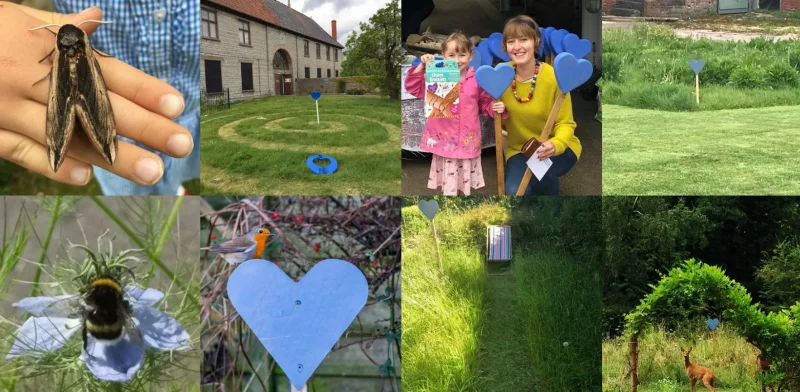“We are striving to improve biodiversity and support nature recovery across all of our greenspaces.”
A blue heart symbol is staked in the ground over the area undergoing nature recovery.
.
Back in the late summer of 2020, there was a real push by central and local government to establish ‘nature recovery networks’:
Government commits to protect countryside for nature
Wildlife Trusts launch national nature recovery campaign
Creating a nature recovery network for East Devon and the UK – Vision Group for SidmouthThe county has its plans:
The Wildlife Trusts describe a Nature Recovery Network (NRN) as a joined-up system of places (habitats) important for wild plants and animals, on land and at sea. It will provide the habitats that wildlife needs to feed, breed, sleep and move from place to place. Critically it will allow the natural world to adapt to change.
This network of habitats will also provide a range of other critical benefits such as carbon sequestration, flood control, clean water, healthy soils and recreational opportunities.
The Devon Nature Recovery Network will form part of a national Nature Recovery Network, a key commitment in the government’s 25 Year Environment Plan.
Devon Nature Recovery Network – Devon Local Nature Partnership
As does the East Devon AONB:
In parallel, the District Council set about its own plans:
Helping to ‘stitch back together Britain’s tattered natural fabric of wild land’.
Creating a nature recovery network for East Devon – Vision Group for Sidmouth
District council bosses go wild for East Devon ‘nature recovery network’ bid | eastdevonnews.co.uk
And this month, StreetScene at the District Council have put ample flesh to these plans with a substantial finalising of their approach for this year, which has now been updated on their website:
Nature Recovery
At East Devon we are striving to improve biodiversity and support nature recovery across all of our greenspaces. This means we are using information on historical, ecological, environmental and human use to inform our green space strategies across the area.
With nature recovery, we aim to:
- Reduce human intervention in ecological processes
- Allow and enable wildlife to thrive (with an emphasis on insects)
- Plant trees to capture and store carbon
- Provide beautiful recreational spaces
We will do this using the following strategies:
- Reduce the frequency, area and deck height when cutting grass
- Establish ecologically appropriate plants across our green spaces to help wildlife
- Transition away from carpet bedding towards more herbaceous and woody perennial plantings
- Plant trees and hedgerows
- Establish wildflower meadows
- Create wetland areas
- Install bird and bat boxes & bee and bug homes across our area
Biodiversity
We hear the term ‘biodiversity’ a lot these days but how many of us truly understand its definition and the consequences of not doing everything we can to help it?
Biodiversity is the variety of species, habitats and ecosystems that support life – ours! It underpins the air we breathe and the food we eat. We depend on biodiversity for protection against pollution, flooding, climate breakdown and a lot more. The areas we are rewilding provide much-needed habitats for insects, especially those facing extinction, and have the many advantages that biodiversity brings. Let’s face it, without biodiversity, human life is threatened.
So, now we are fully aware of its importance to us all, what are we doing about biodiversity losses that scientists estimate will lead to the extinction of 1 million species within our lifetime if we do not act now?
Blue Heart Campaign

Have you seen our blue hearts across the district? The initiative promotes the renaturing of our green spaces in selected parks, gardens and verges, which are allowed to grow throughout the season. A blue heart symbol, made out of recycled materials, is staked in the ground over the area undergoing nature recovery. This communicates to and sets expectations of residents and visitors that a deliberate act of nature recovery is in process to raise biodiversity levels – rather than the area being left out of neglect or because the land owner has forgotten to mow it.
What can I do to help?
Firstly, your understanding of what we are doing as a Council, why we are doing it and its local, regional and global importance will help to set expectations of what is required to counter the consequences of a century or more of everybody keeping their lawns unnaturally short.
Secondly, you can decide which sections of your lawn/garden, no matter how small, you want to let grow wild. The average closely-mown lawn will consist of several species of grass (e.g. annual meadow grass, Yorkshire fog, couch grass, and maybe one or two others) and several species of annual and perennial wildflowers (e.g. daisy, yarrow, clover, buttercup, dandelion and quite a few more, depending on whether you have used weed killer in the past). So, if you decide not to mow your lawn – or sections of your lawn – from the spring, those wildflowers and grasses will finally be allowed to grow, flower and seed – which will help biodiversity! It may take a few years for you to achieve the right balance between flowers and grasses, and you may want to sow a wildflower mix to increase your biodiversity, but that’s essentially it. If you want to create a wildflower garden from scratch, you can learn how to here (Get growing with the RHS: How to grow a mini meadow / RHS Gardening)
Please use the following hashtag #EDDCparks on Twitter to find out more about our rewilding.
East Devon’s Diverse Insects and Animals
We recognise that we are fortunate to have a diverse range of insects and birds across East Devon. Here are some that you can expect to see now, which we hope continue to survive and flourish:…
List of Nature Recovery sites:
…